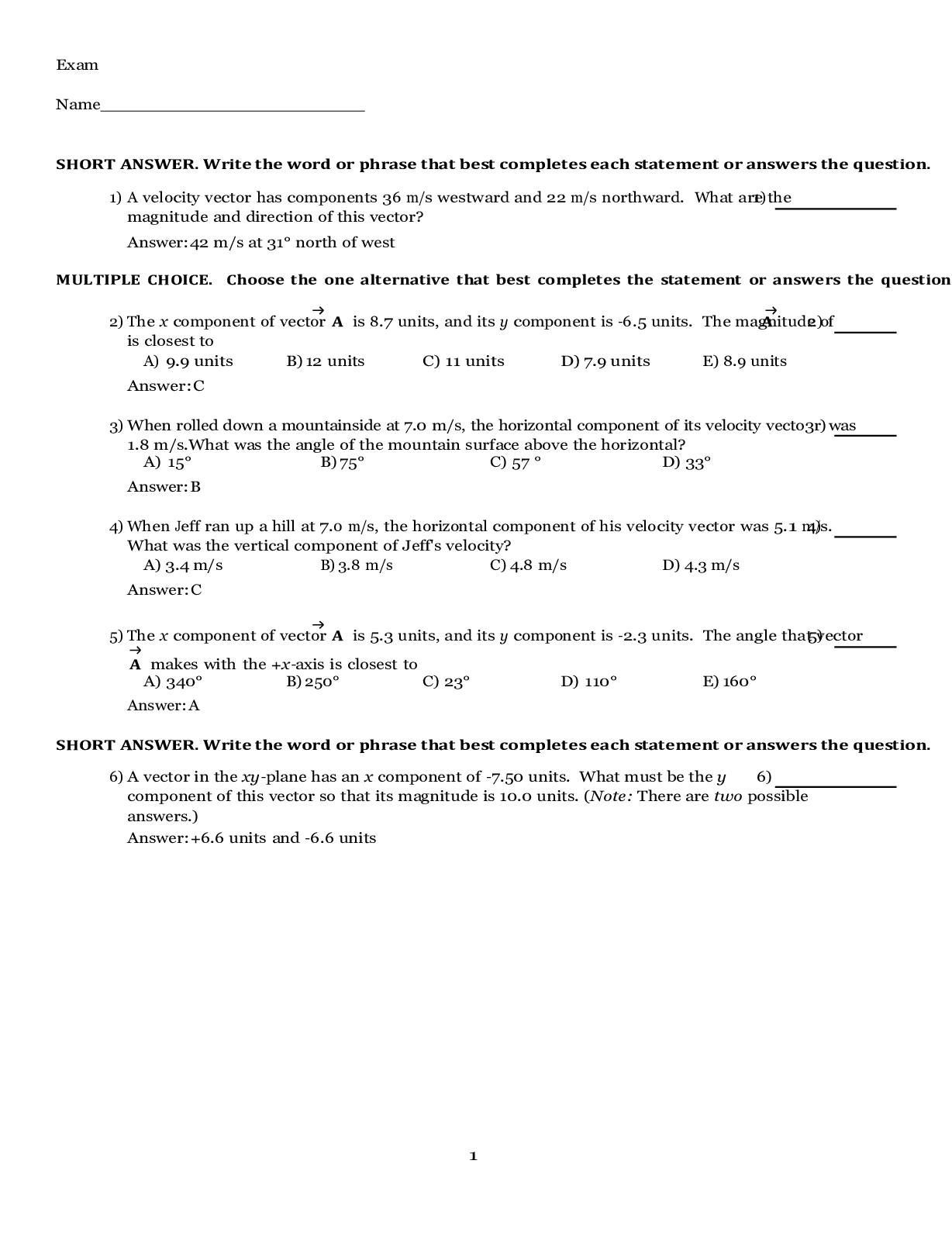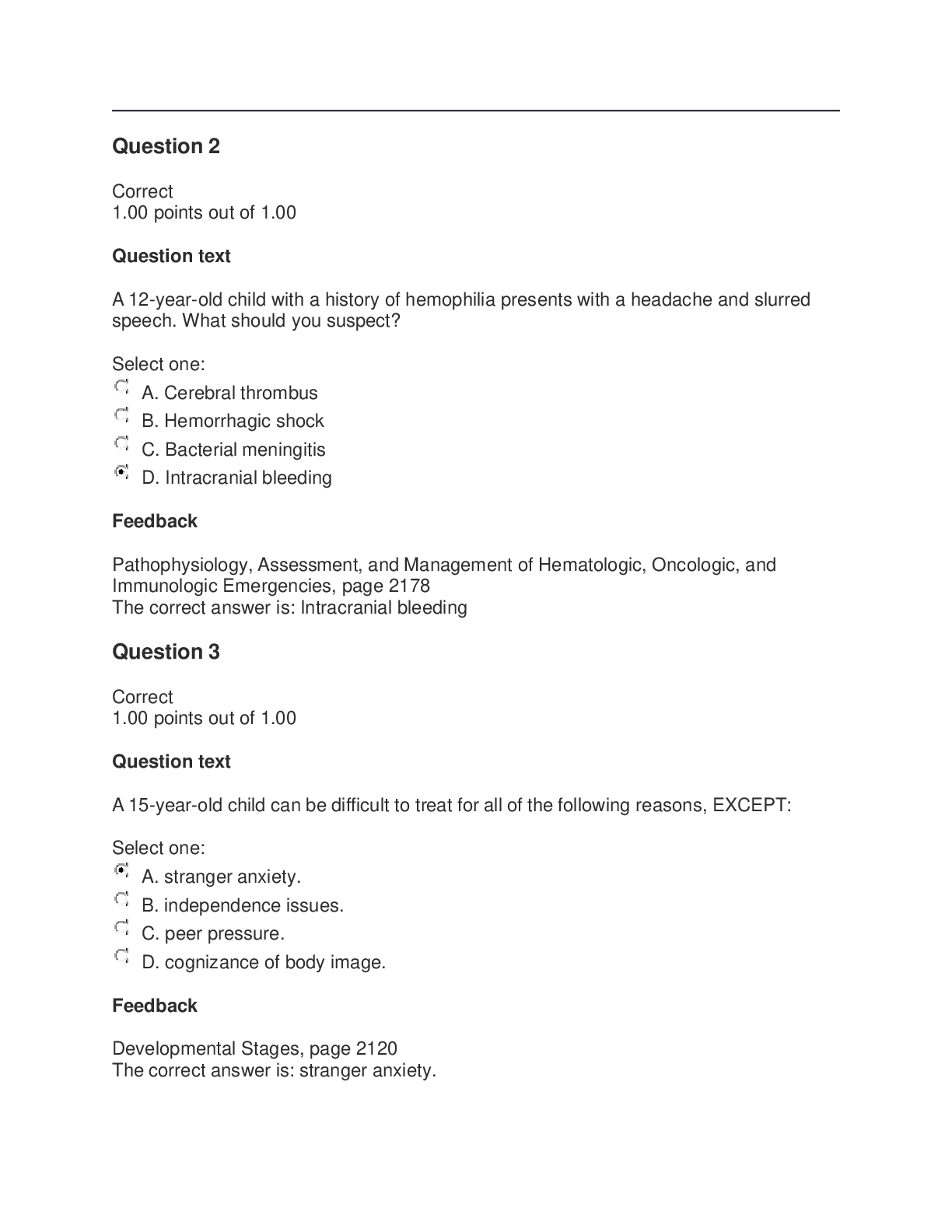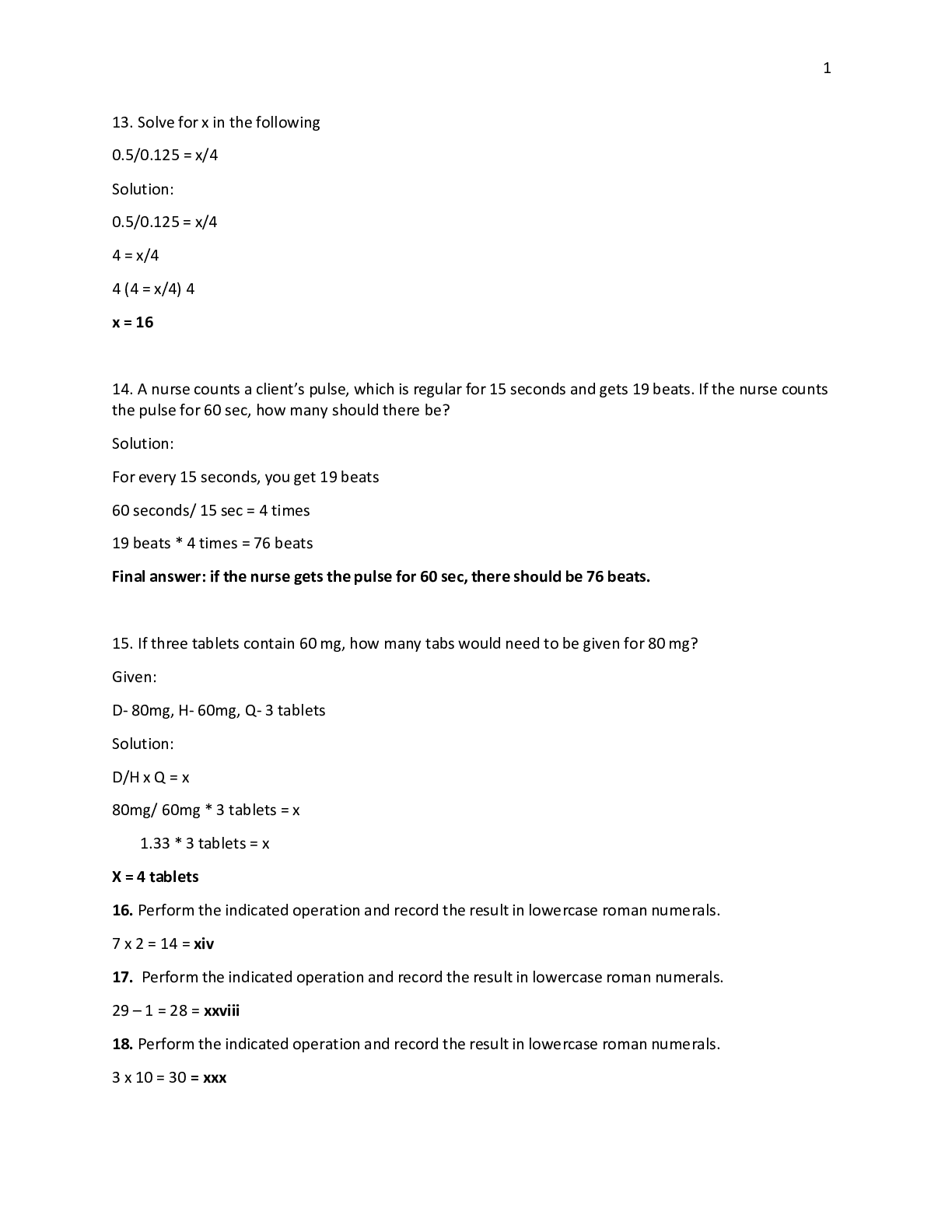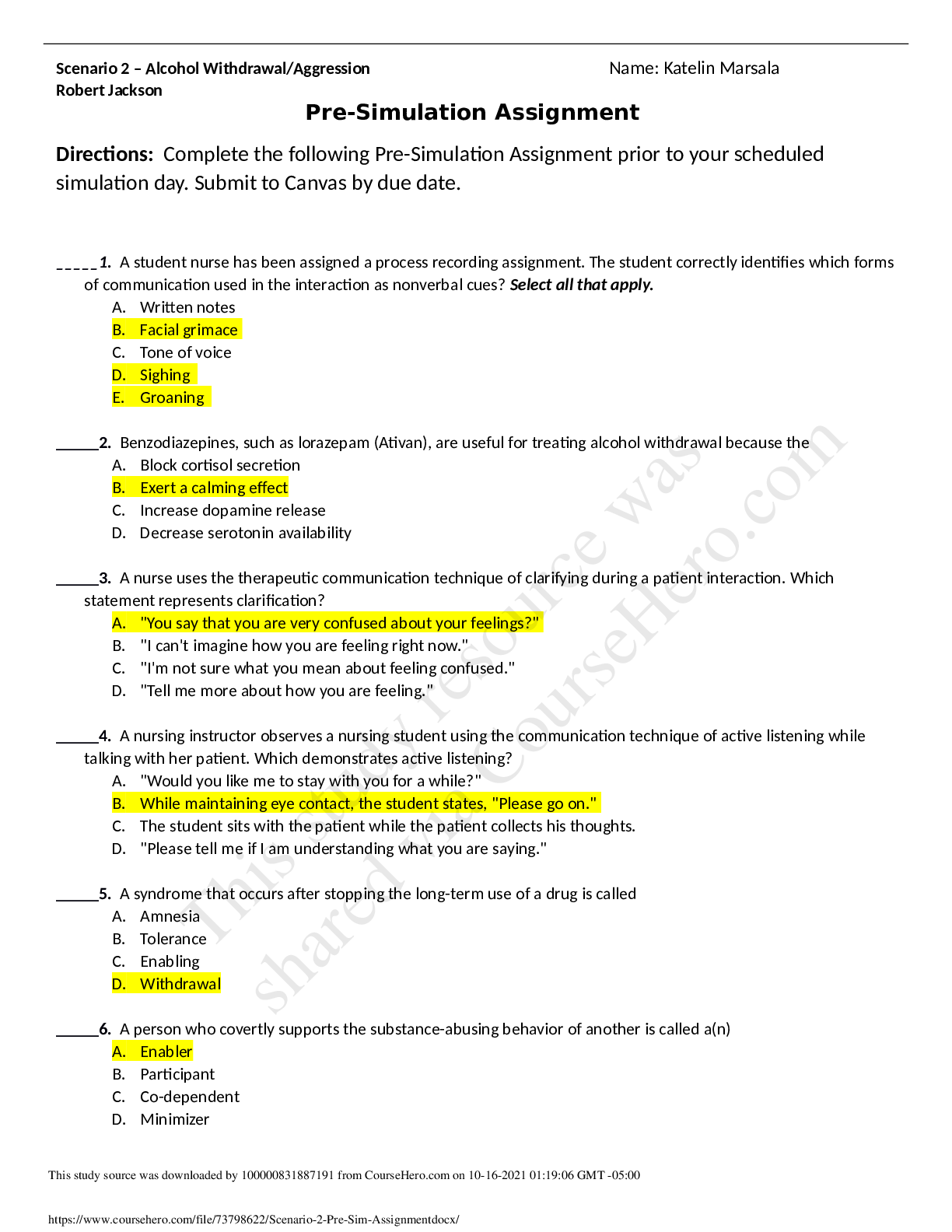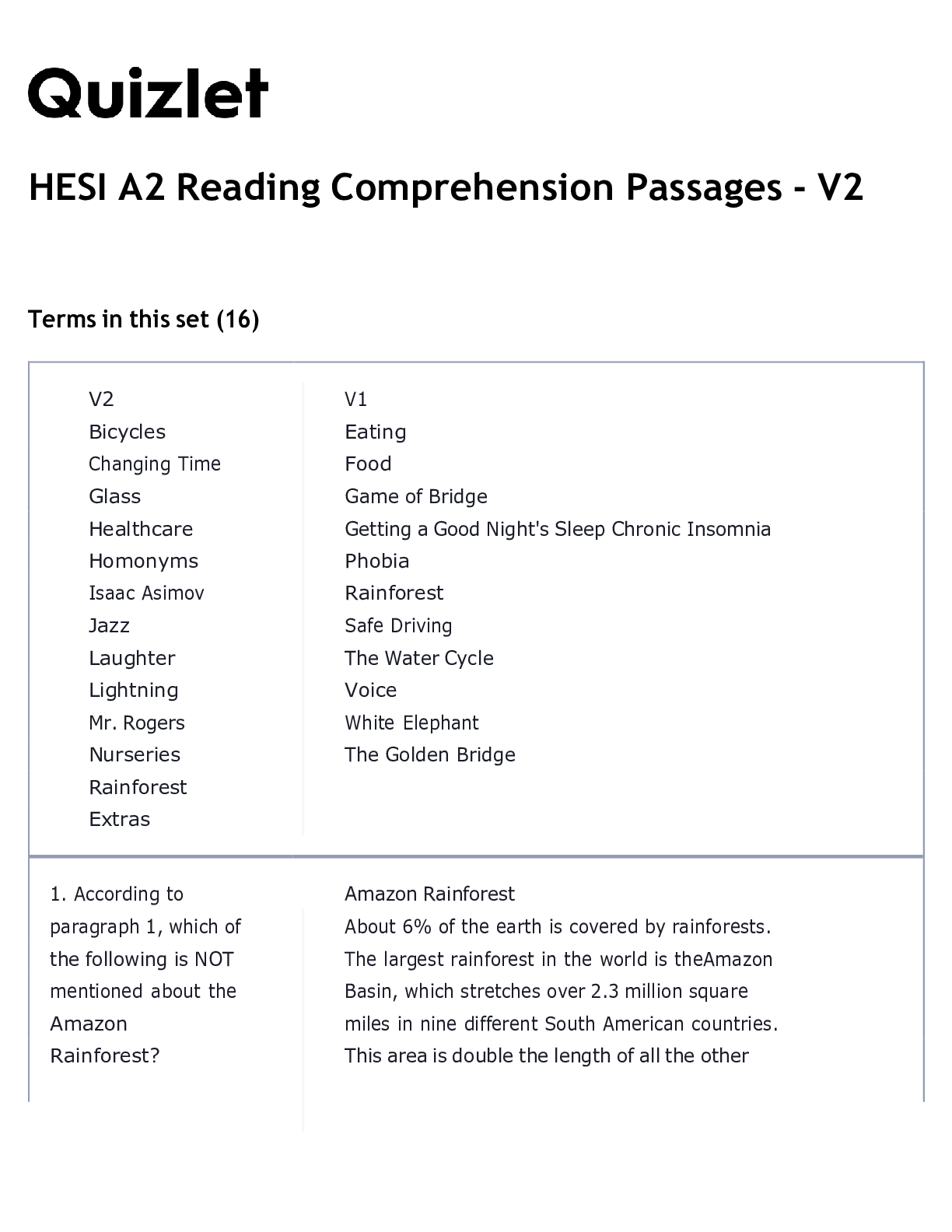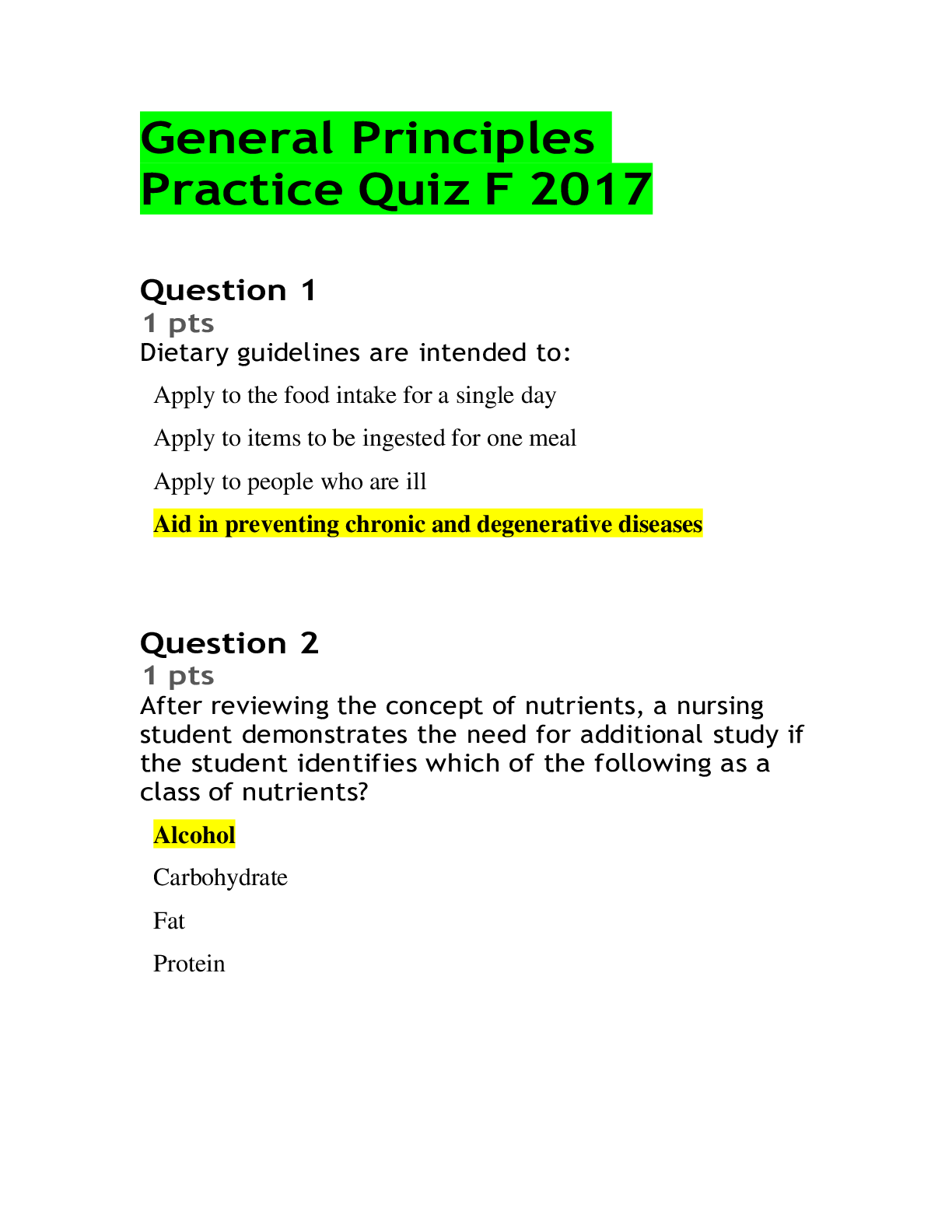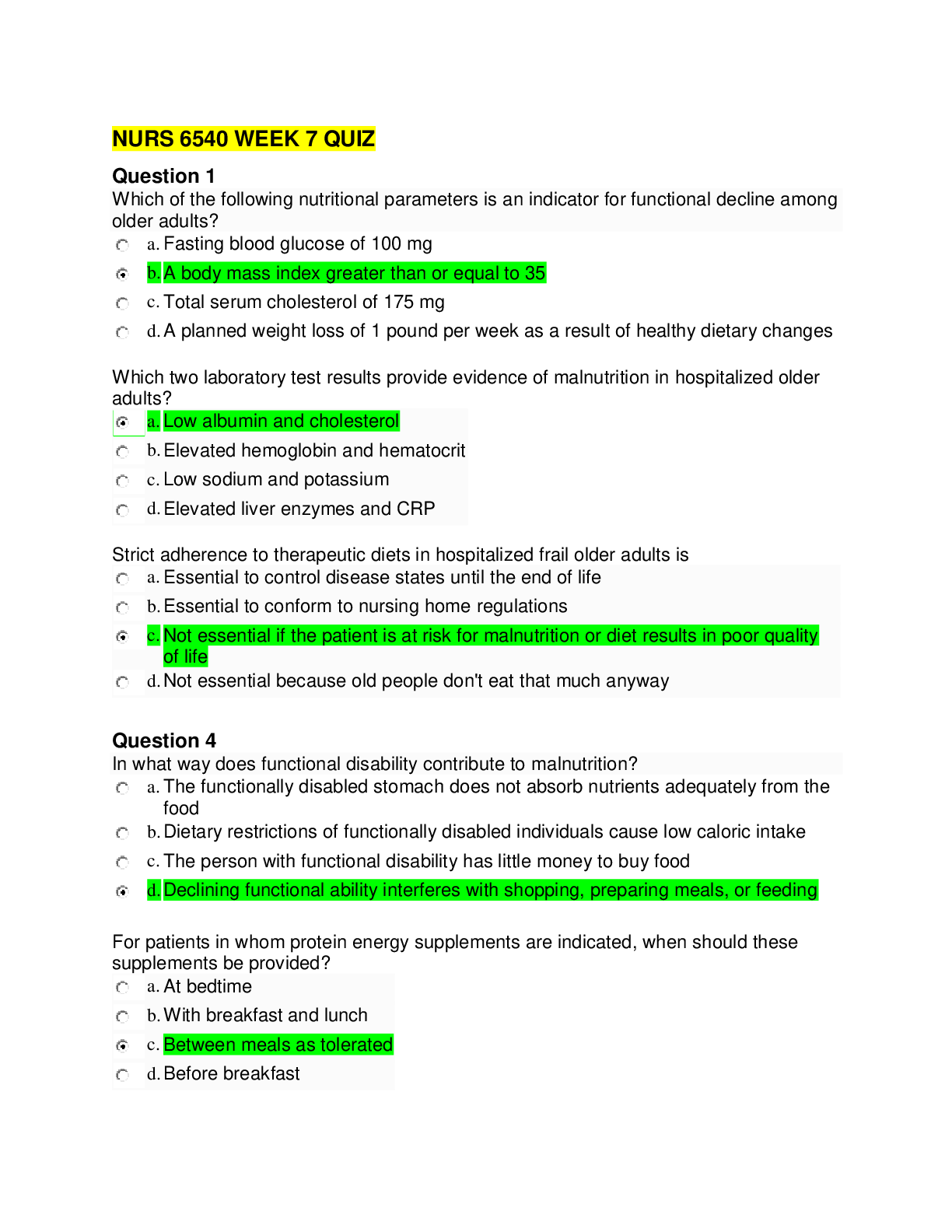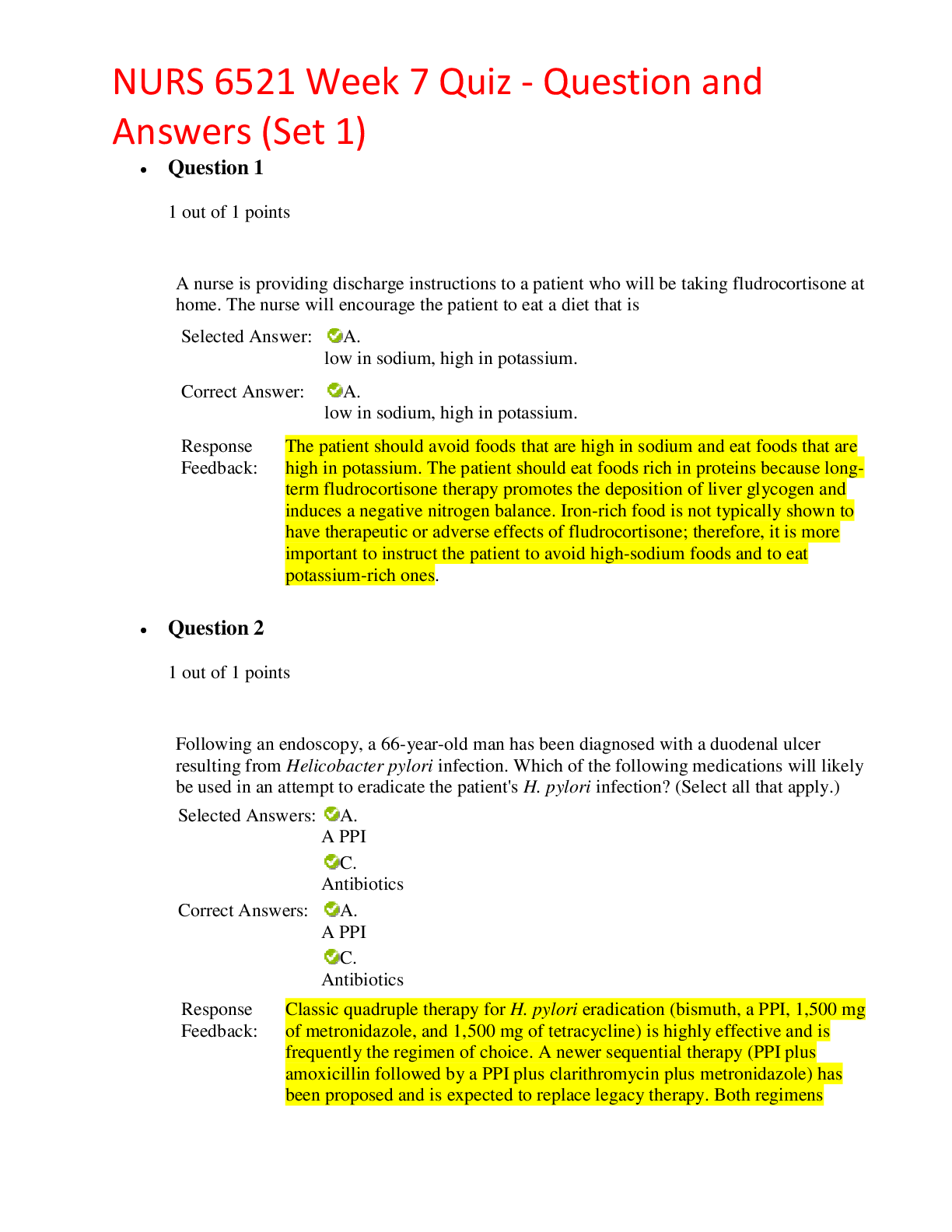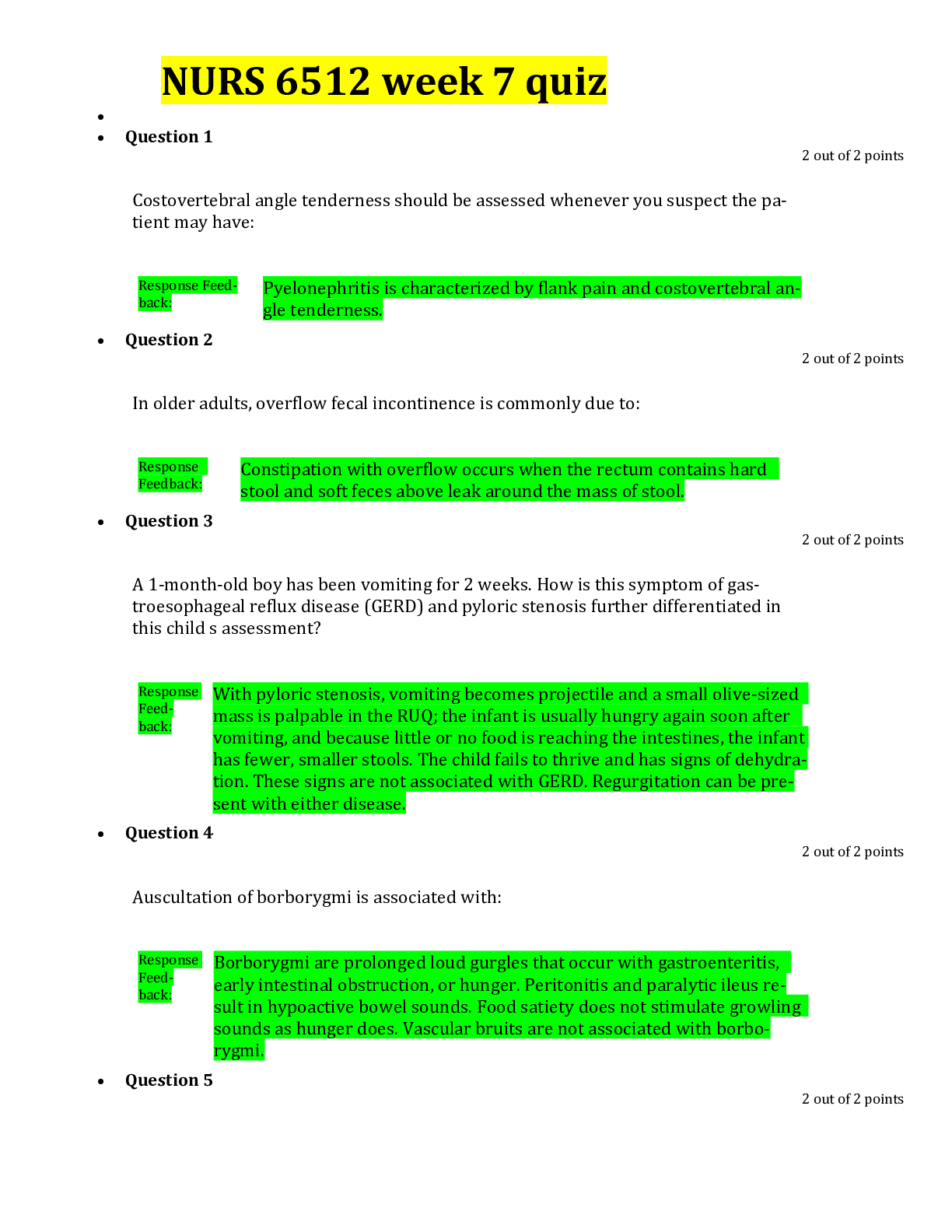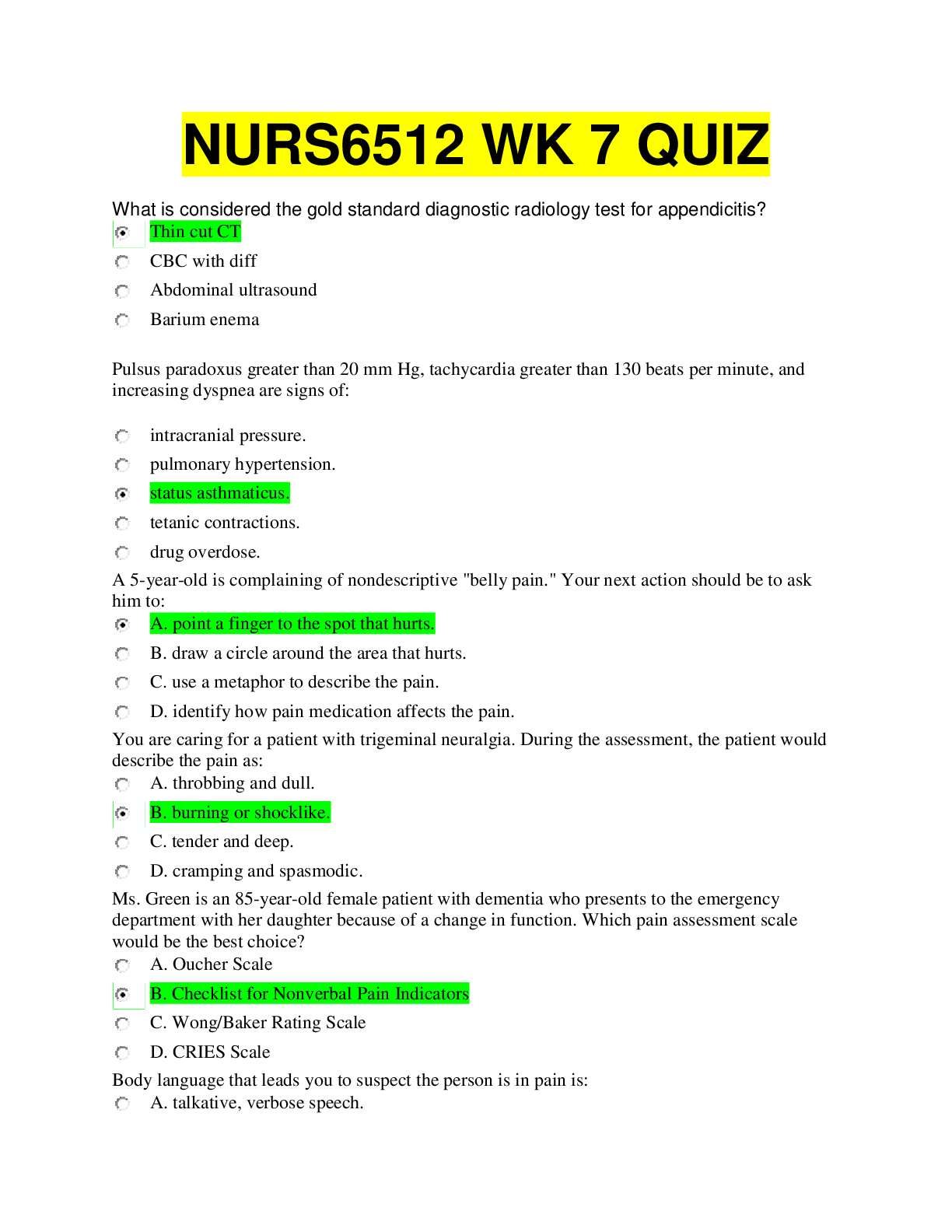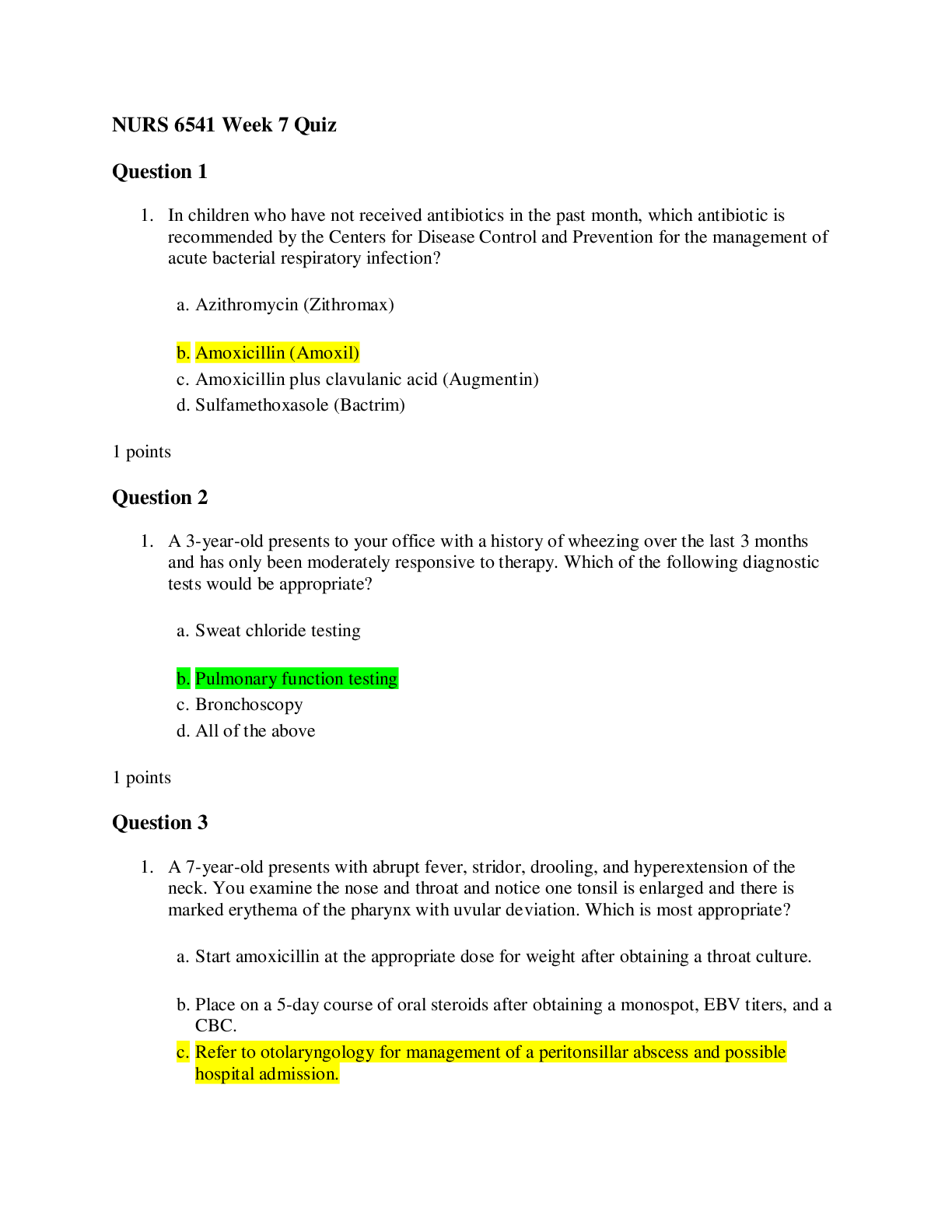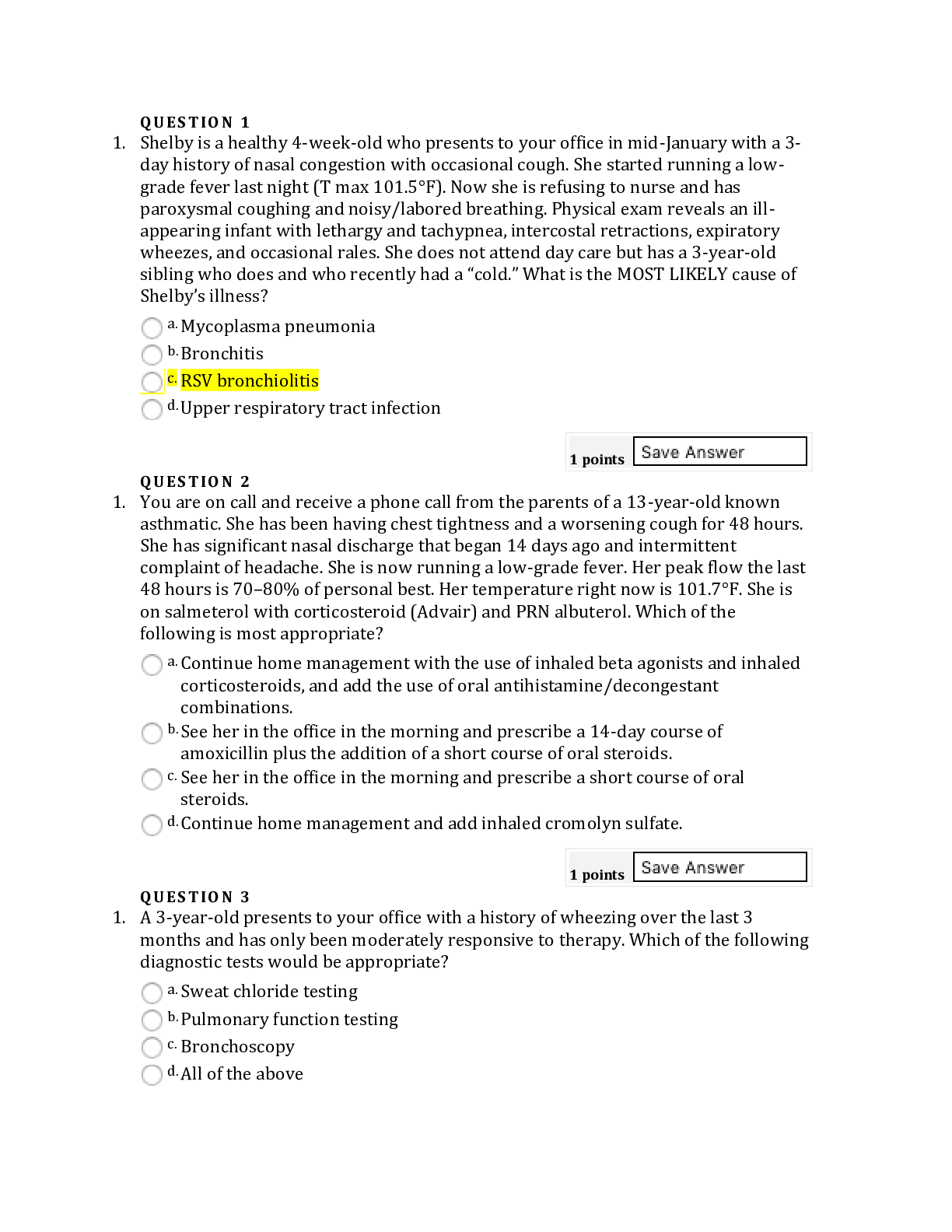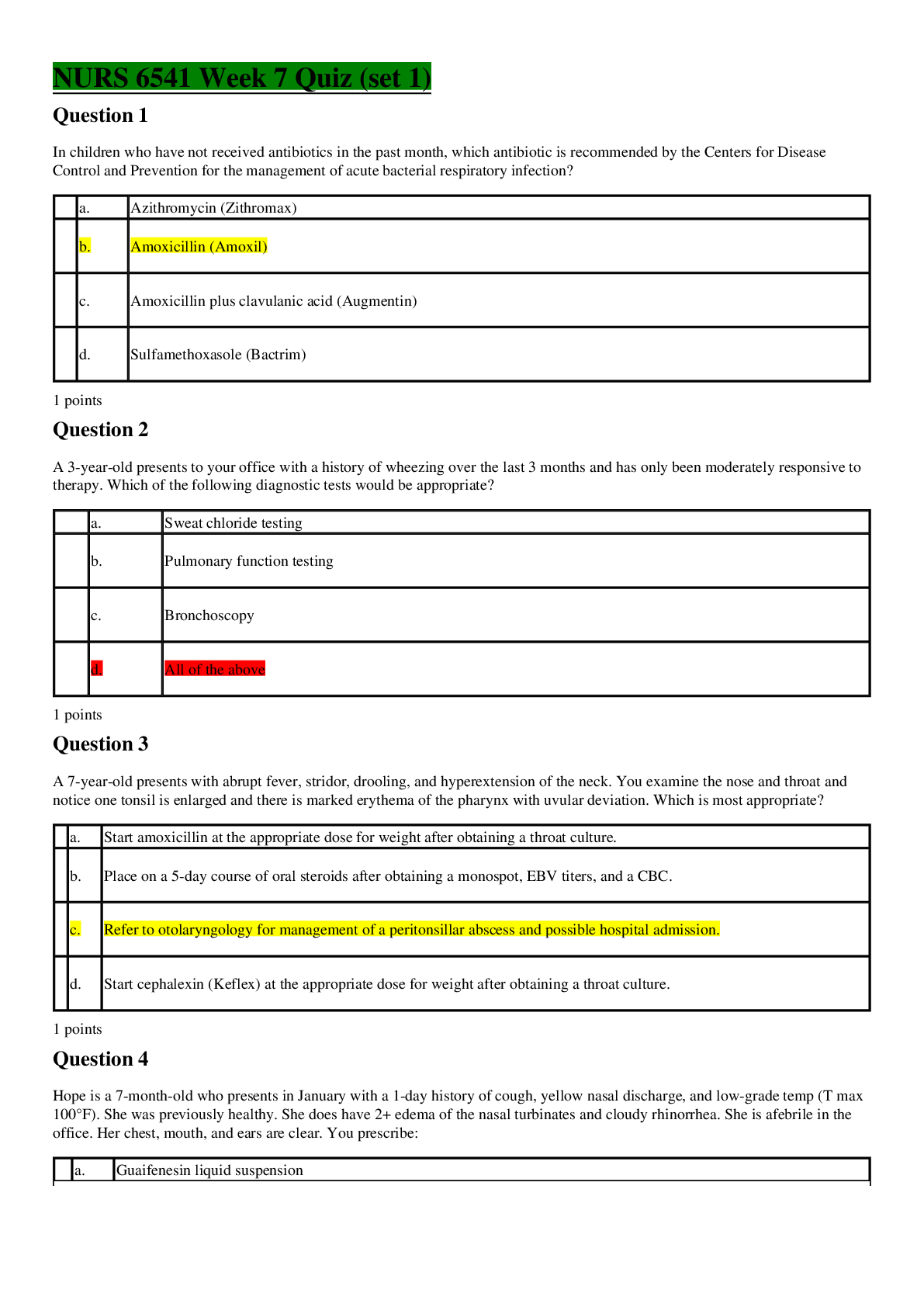Pathophysiology > QUESTIONS & ANSWERS > Advanced Pathophysiology Week 7 Quiz (All)
Advanced Pathophysiology Week 7 Quiz
Document Content and Description Below
Advanced Pathophysiology Week 7 Quiz Question 1 2 / 2 pts Most dysphasias are associated with cerebrovascular accidents involving which artery? Correct! Dysphasias usually are associate... d with cerebrovascular accident involving the middle cerebral artery or one of its many branches. Question 2 2 / 2 pts Vomiting is associated with CNS injuries that compress which anatomic location(s)? Vomiting is associated particularly with CNS injuries that (1) involve the vestibular nuclei (located in the lower pons and medulla oblongata) or their immediate projections, particularly when double vision (diplopia) also is present. Question 3 2 / 2 pts Cognitive operations cannot occur without the _____ functioning. Awareness encompasses all cognitive functions that embody awareness of self, environment, and affective states (i.e., moods). Consciousness often is viewed as having two distinct components: arousal and awareness. Arousal, an attentional system, is the state of awakeness that an individual exhibits. Level of arousal is mediated by the reticular activating system. Question 4 2 / 2 pts Dilated and sluggish pupils, widening pulse pressure, and bradycardia are clinical findings evident of which stage of intracranial hypertension? Correct! Stage 3 of intracranial hypertension presents clinical manifestations that include decreasing levels of arousal, Cheyne-Stokes respiration or central neurogenic hyperventilation, pupils that become sluggish and dilated, widened pulse pressure, and bradycardia. Question 5 2 / 2 pts Which description is consistent with a complex partial seizure? A complex partial seizure results in impaired consciousness as well as the inability to respond to exogenous stimuli. Question 6 2 / 2 pts Cerebral edema is an increase in the fluid content of the Correct! Cerebral edema is an increase in the fluid content of brain tissue: a net accumulation of water within the brain. Question 7 2 / 2 pts Since his cerebrovascular accident, a man has been denying his left hemiplegia. What term is used to describe this finding? Anosognosia is ignorance or denial of existence of the disease. Question 8 2 / 2 pts The existence of regular, deep, and rapid respirations after a severe closed head injury is indicative of neurologic injury to the Central reflex hyperpnea, a sustained deep rapid but regular pattern (hyperpnea), may result from central nervous system damage or disease that involves the lower midbrain and upper pons. It is seen after increased intracranial pressure and blunt head trauma. Question 9 2 / 2 pts Atheromatous plaques are most commonly found Correct! Over 20 to 30 years atheromatous plaques (stenotic lesions) tend to form at branchings and curves in the cerebral circulation. Question 10 2 / 2 pts Amyotrophic lateral sclerosis (ALS) is characterized by Correct! . ALS (sporadic motor system disease, sporadic motor neuron disease, motor neuron disease) is a worldwide degenerative disorder diffusely involving lower and upper motor neurons. Question 11 2 / 2 pts A man was in an automobile accident in which his forehead struck the windshield. A blunt force injury to the forehead would result in a coup injury to the _____ region. The focal injury may be coup (directly below the point of impact). Objects striking the front of the head usually produce only coup injuries (contusions and fractures) because the inner skull in the occipital area is smooth. Question 12 2 / 2 pts Myasthenia gravis . The disease is characterized by exertional fatigue and weakness that worsens with activity, improves with rest, and recurs with resumption of activity. Question 13 2 / 2 pts Which electrolyte imbalance contributes to lithium toxicity? A potentially serious side effect is lithium toxicity. Lithium is normally removed from the kidneys; however, when the body is sodium depleted, the kidneys reabsorb sodium along with lithium. Question 14 2 / 2 pts Which is a positive symptom of schizophrenia? Positive symptoms frequently occur during a psychotic episode, when an individual loses touch with reality and experiences something that should be absent (e.g., hallucinations). Question 15 2 / 2 pts What are the most common side effects of selective serotonin reuptake inhibitors (SSRIs)? Common side effects of SSRIs include sleep disturbances (e.g., insomnia) and nausea. Question 16 2 / 2 pts Which defects of neural tube closure are most common? Posterior defects are most common. Question 17 2 / 2 pts Anterior midline defects of neural tube closure cause developmental defects in the These developmental defects may cause brain and skull abnormalities. Question 18 2 / 2 pts The life-threatening problems associated with myelomeningocele include Correct! . One serious, potentially life-threatening problem associated with myelomeningocele is the Arnold-Chiari type II malformation. This deformity involves the downward displacement of the cerebellum, cerebellar tonsils, brainstem, and fourth ventricle. Question 19 2 / 2 pts Symptoms characteristic of bulimia nervosa include: Diagnosis of bulimia is based on among other findings, recurrent episodes of binge eating during which the individual fears not being able to stop. Question 20 2 / 2 pts Gastroesophageal reflux disease (GERD) is a result of Correct! Normally the resting tone of the LES maintains a zone of high pressure that prevents gastroesophageal reflux. In individuals who develop reflux esophagitis, this pressure tends to be lower than normal from either transient relaxation or weakness of the sphincter. Question 21 2 / 2 pts An intestinal obstruction at the pylorus or high in the small intestine causes metabolic alkalosis by causing the . If the obstruction is at the pylorus or high in the small intestine, metabolic alkalosis develops initially as a result of excessive loss of hydrogen ions that normally would be reabsorbed from the gastric juice. Question 22 2 / 2 pts Foods eliminated from the diet for children who have gluten-sensitive enteropathy (celiac sprue) include Treatment consists of the immediate and permanent institution of a diet free of cereal grains (wheat, rye, barley, oats, malt). Lactose intolerance is presumed because of damage to the villi; therefore, lactose (milk sugar) is excluded from the diet. Question 23 2 / 2 pts _____ diarrhea results from lactose intolerance. The malabsorption of lactose results in osmotic diarrhea, in which fluids move by osmosis from the vascular compartment into the intestinal lumen. Question 24 2 / 2 pts At 2 or 3 weeks of age, an infant who has been fed well and gained weight begins to vomit for no apparent reason. The vomiting has gradually become more forceful. These symptoms may be indicative of which disorder? Clinical manifestations of pyloric stenosis can present between 2 and 3 weeks after birth; an infant who has fed well and gained weight begins to vomit without apparent reason. The vomiting gradually becomes more forceful. Question 25 2 / 2 pts Congenital aganglionic megacolon (Hirschsprung disease) involves inadequate motility of the colon caused by neural malformation of the _____ nervous system. Congenital aganglionic megacolon is caused by a malformation of the parasympathetic nervous system. [Show More]
Last updated: 2 years ago
Preview 1 out of 9 pages
.png)
Buy this document to get the full access instantly
Instant Download Access after purchase
Buy NowInstant download
We Accept:

Reviews( 0 )
$14.00
Can't find what you want? Try our AI powered Search
Document information
Connected school, study & course
About the document
Uploaded On
Jan 14, 2021
Number of pages
9
Written in
Additional information
This document has been written for:
Uploaded
Jan 14, 2021
Downloads
0
Views
92


.png)


